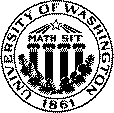The Course
This course is an introduction to differential calculus. We will talk about functions and their derivatives, as well as related ideas like limits and continuity. In addition to the usual facts about derivatives, like the product rule and the chain rule, we will spend quite a bit of time talking about applications. This means the homework will involve a lot of story problems, particularly later on in the quarter. If you want a good grade in this class, you should expect to spend about 10 hours a week on homework.
Back to Campus
Now that the UW has returned to campus, I plan to hold this class as close to normal as possible. Lectures, quiz sections and exams will be in the classroom. I do plan to have all office hours on Zoom, and we will be using Gradescope to grade the exams. Unfortunately, our classroom is not set up to use Panopto so I will not be recording lectures. We do have an on-line section of Math 124 and this could be a good option for people who are uncomfortable about coming to the classroom.
Grades
Your grade is determined by how you do relative to the class as a whole.
I expect that the median grade in this class will be about 2.9.
Grades will be based on total points earned. There are 270 possible points:
- Worksheets--20
- Homework--50
- 2 Midterms--50 points each
- Final--100
If your overall score is 60%, you are guaranteed a grade of 2.0.
Text
Calculus, Early Transcendentals by James Stewart
(The Eighth Edition).
The only thing that students are required to purchase for this course is access to Webassign.
The textbook is "Calculus" by Stewart, vol.1 available in the UW bookstore. This is a portion of the hardbound text "Calculus, 8th Edition, Early Transcendentals" by Stewart. The custom version vol. 1 covers Math 124/5 at the UW. The custom version vol. 2 covers Math 126/324 at the UW. In addition to the textbook, you will need access to Webassign. You can purchase this bundled with the textbook at the bookstore OR you can purchase it on-line.
The cheapest option is to log into WebAssign and purchase it there. This will come with an electronic version of the text. Please note that you have the option to buy for single term or multi-term. Multi-term is the best deal if you plan to take Math 126.
Homework
will be assigned daily, see the
WebAssign site for the problems due. (Note that it is important to login to WebAssign at this site. If you just google for it, you will have problems.) You are responsible for all the problems assigned (ie: any of it could appear on the exams).
Quizzes and Exams
- There are no quizzes this quarter.
- There will be 2 midterm exams. They
will be given on the dates listed in the syllabus. They are meant to take 50 minutes but you can
take the full 80 minutes of Quiz Section. You must bring a Photo ID to all exams.
- The final exam
will take place from 1:30pm to 4:20pm on Saturday, December 11. Note that this is not the time listed
in the final exam schedule.
It will be held in
Kane 110.
back to the top
Rules for taking exams
- You must bring a photo ID. Husky Card is fine.
- You are allowed to use one handwritten 8.5 by 11 sheet of notes. 2-sided is OK.
- The only calculator allowed is the Texas Instruments TI-30X IIS.
- There are no make-up exams. If you have a compelling and
well-documented reason for missing a test, speak to the professor about it.
Religious Accomodation
Washington state law requires that UW develop a policy for accommodation of student absences or significant hardship due to reasons of faith or conscience, or for organized religious activities. The UW's policy, including more information about how to request an accommodation, is available at Religious Accommodations Policy. Accommodations must be requested within the first two weeks of this course using the Religious Accommodations Request form.
Quiz section
On Tuesdays and Thursdays you will meet with a Teaching Assistant in a smaller group.
This gives you a chance to get more of your questions answered. Tuesday's quiz section
will be 80 minutes long so that, in addition to getting help with your homework, there
will be time for a worksheet that you can work on while the TA circulates and answers questions. The midterm exams will be held in Quiz Section.
The TAs are:
| Sections | Name | Office | Email |
| FA & FB | James Hazelden | NA | jhazelde 'at' uw.edu |
| FC & FD | Anya Hanson | NA | aeeh 'at' uw.edu |
| FE & FF | Alexander Wang | NA | awaw 'at' uw.edu |
Calculators
There is a required calculator for Math 124. It is the Texas Instruments TI-30X IIS which can be purchased from many places for well under $20. The UW Bookstore carries orange ones, which they will buy back at the end of quarters, but any color is acceptable for Math 124.
You should show all work not doable on a scientific calculator. For instance, when you solve a quadratic
equation, steps must be shown even if your calculator can produce the solutions.
back to the top

